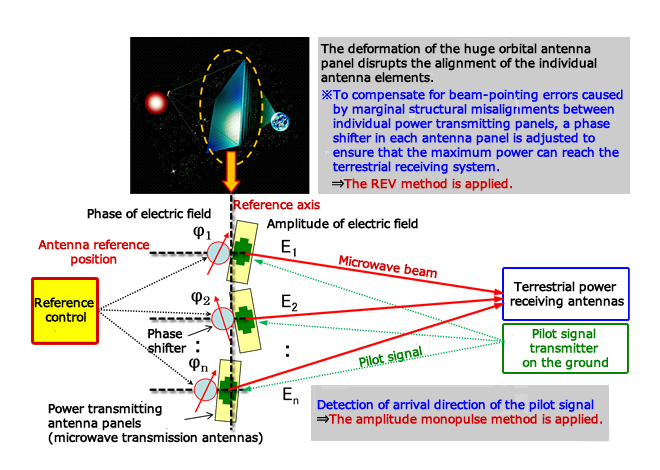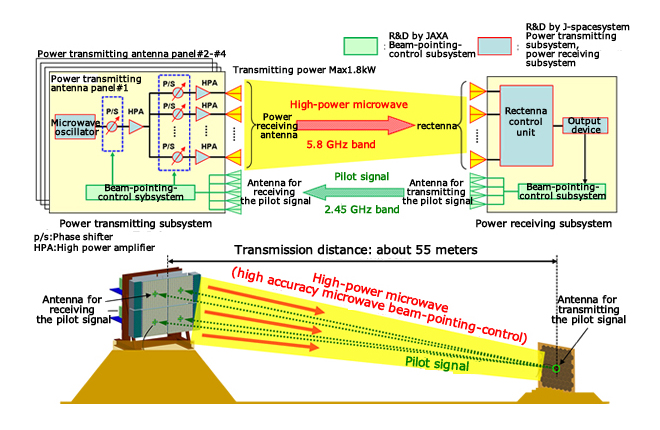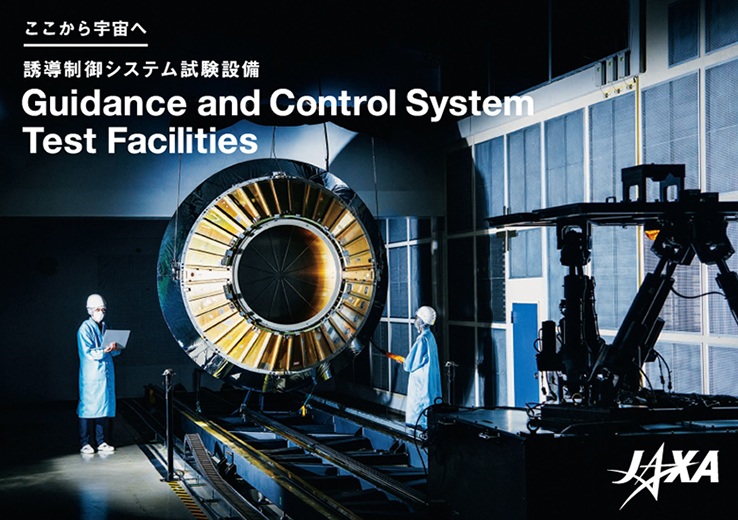Advantages of microwaves power transmission
- Microwaves (operated at frequencies less than 10 GHz) can penetrate cloud cover and rainfall.
- Microwaves have lower energy density than lasers, which makes them safer.
R&D on high-accuracy microwave beam-pointing-control technology
The SSPS Research Team has been intensively researching a technology to steer a beam of microwaves in the direction of any target with very high accuracy. A large-scale SSPS capable of supplying 1 GW (1 million kW) of output power to the ground site from geostationary orbit (GEO) 36,000 kilometers above the Earth’s surface would require a microwave beam-pointing with an extremely high accuracy. If a pointing accuracy of 0.001 degrees (i.e., a pointing deviation of several hundred meters) can be obtained, it will be possible to safely and efficiently transmit the microwave energy over the 36,000 km distance from the kilometer-sized orbital huge phased array antenna to a terrestrial power receiving antenna site with an estimated diameter of 2 kilometers.
The surface of a huge orbital phased array antenna panel would be mounted with several billion antenna elements each of which are aligned along the position of the antenna reference point. The individual antenna panels could not be kept in a rigid structure with respect each other because the total mass of such a vast number of antenna panels would inevitably deform the planar surface. The misalignment would have to be offset electronically in order to accurately control the microwave beam-pointing mechanism.
A software retrodirective system is used to allow for applications to future space programs that require high-accuracy beam pointing control technology. In the system we envision, a pilot-signal-transmitting antenna mounted on the terrestrial-power-receiving antenna panel transmits the pilot signal to pilot-signal-receiving antennas mounted on the orbital-power-transmitting antenna panels to let the power transmitting antenna array know the direction in which to send the microwave. The angle between the direction in which the signal arrives and the normal to the array can be detected accurately by the amplitude monopulse method, and the phase of the microwaves is adjusted to point the microwave beam in the right direction. To ensure that the maximum power can reach the terrestrial power receiving antenna, the phase of the microwaves on each power transmitting antenna panel is further adjusted by a Rotating-Element Electric-Field Vector (REV) method based on the beam intensity data received. We have been researching and developing a unique microwave beam control method and control algorithm that incorporate the combined effects of the amplitude monopulse and REV methods.

(with the amplitude monopulse and REV methods)
Ground demonstrations on microwave wireless power transmission
The SSPS Research Team has been working with Japan Space Systems (J-spacesystems) to advance R&D on a highly accurate technology for controlling microwave wireless power transmission. In FY2014, we conducted the ground demonstration of high-power microwave wireless power transmission technology in the 5.8 GHz band. The wireless power transmission ground test model like that depicted below was fabricated to evaluate the accuracy (target: 0.5 degree RMS) with which a microwave beam-pointing can be directed inside an anechoic chamber. JAXA was responsible for developing the microwave beam-pointing-control subsystem for the ground test model. JAXA developed the high-accuracy microwave beam-pointing controller with the accuracy 0.15 degree RMS, and demonstrated the efficacy of the beam-pointing control technique. The demonstration was made with kW-class high-power 5.8 GHz band microwave power transmission. The demonstration was also designed to simulate the deformation of the huge antenna panel by thermal distortion and gravity gradient torque in space.
Another wireless power transmission test was performed outdoors to demonstrate microwave wireless power transmission over a distance of about 50 meters, and the receiving power was supplied to its user actually.
Ground Demonstration of Microwave Wireless Power Transmission

Technological challenges
Several technological tasks lie ahead of us in our work to develop microwave wireless power transmission technology.
- Enhance the accuracy of the microwave beam-pointing-control.
- Increase the conversion efficiency from DC power to microwaves (in space)
- Increased the conversion efficiency from microwave to DC power (on the ground)
- Reduce the size and weight of the electronic modules








